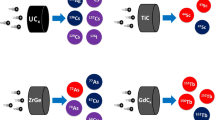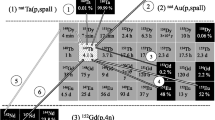Abstract
Research in extending medical isotopes for the diagnosis and treatment of numerous health maladies is hampered by outages and upsets in major supply sources. Investigations in cures for brain cancer (211At), HIV/AIDS virus (213Bi), and even bacterial vectors are either in reduced progress mode or have been cancelled until isotopes become available. Examples of several key radioactive medical isotopes include 99mTc for diagnostics, 131I for non-Hodgkin’s lymphoma and thyroid cancer, 225Ac for acute myelogenous leukemia, and 67Cu for lymphoma cancer. Possibilities for developing commercially viable sources using compact accelerators and next generation research and production reactors are discussed.
Similar content being viewed by others
Avoid common mistakes on your manuscript.
Introduction
In 1977, Dr. Rosalyn Yalow was awarded the Nobel Prize for her pioneering work in and invention of radio-isotopic immunoassay of endogenous insulin in man [1]. This effort demonstrated the potential to direct radio-isotopes to specific body locations or for metabolic pathway determinations. This technique provided a means of viewing bodily functions in situ and in real time. Since then, a number of efforts have successfully advanced her methods [2] for the targeted medical application of isotopes in both diagnosis and therapy of numerous medical maladies. As a result, tens of thousands of diagnostic medical isotope procedures such as heart, renal, and brain function with 99mTc are performed daily worldwide.
In addition to diagnostics, medical isotopes have been developed into several direct or in situ therapy methods such as 131I for non-Hodgkin’s Lymphoma [3] and thyroid cancer [4], 225Ac for acute myelogenous leukemia [5], 67Cu for lymphomas [6], 211At for research in brain cancer therapy [7], 213Bi for research in HIV/AIDS virus therapy [8] and many others [9].
Challenges
Significant advancement in medical isotope applications is limited by availability and approval of currently rare but attractive isotopes which have appropriate half-lives, decay modes, and chemical affinities. Traditional sources such as isotope production or research reactors are currently suffering upsets [9], end-of-life cycle issues (Table 1) and limited activation regimes (Table 3). The US National Academy of Sciences has identified supply issues with focus on the demise of national funding of supplies and innovative research and unstable production [10]. A production risk is the 2008 decision by Atomic Energy Canada Ltd [11]. canceling the MAPLE Reactor development for replacement of the National Research Universal (NRU) reactor resources at Chalk River. This decision along with issues regarding highly enriched uranium [12] impact production of 99Mo/99mTc which affects over 70,000 medical procedures per day [9] in North America. Major suppliers in Europe [13], South Africa, and Australia have also shown supply interruptions or limitations [14]. These world reactor primary suppliers are shown in Table 1. Additional and newer reactors and technologies are needed to fill the gaps. A number of isotopes as shown in Table 2 are technically available for use in medical applications [15]. However, due to production challenges, many such as 67Cu for lymphoma research [6] have limited availability making research development and clinical trials difficult to the point of cancellation.
Emerging isotopes of interest have certain radiological and biological features. Typically, an isotope of interest needs to have a half life sufficient to be prepared for use, but not too long as to continue an unnecessary exposure risk. Depending on source or preparation, attractive half lives are a few hours to a few days. These short lives require generation within reasonable shipping distances, sometimes requiring generation at the use point either from an isotope generator as for 99Mo/99mTc or an activation method such as a local reactor or accelerator. Local generation of 18F for Positron Emission Tomography is an example [16].
A usefully lived isotope must also have a decay radiation compatible with the application. For diagnostic imaging, a positron or gamma emitter is desired in order for the photon to traverse body tissues to the image sensors. For therapy, a moderate energy beta or high energy alpha emitter is desirable. With the isotope at the location of interest such as a cancer cell, the full energy is deposited while surrounding healthy tissue is spared.
The third and most important feature of a desirable isotope is the affinity to bind to a chemical transfer compound which will seek the area of interest. Chelating compounds attachable to monoclonal antibodies which are tailored for target cell affinity are attractive allowing metal element isotopes to be used. In other situations such as for thyroid cancer, the natural uptake of iodine by the thyroid makes 131I the isotope of choice.
Opportunities
Several opportunities exist to use emerging developments in biological and nuclear technologies for production and use of medical isotopes. The historical and conventional approaches use traditional negative ion cyclotrons and thermal reactors. However, certain isotopes are most readily made by tailoring or selecting the reactor neutron energy spectrum. Traditional neutron generators and fast spectrum reactors are necessary to obtain needed production purities and quantities. The energies and isotopes identified in Table 3 imply how these technologies might be developed or deployed. It is conceivable that new reactor designs, especially those with fast spectrum neutrons could include a few production tubes for desired and currently rare isotopes.
Isotope production beyond conventional means is projected to use photon, proton, neutron, and electron accelerator based methods. For example, in 2008, Advanced Medical Isotopes Corporation began production of 18F for PET using a compact linear proton accelerator [16]. This technology is being actively explored for making additional useful isotopes. In addition, both Lawrence Berkeley National Laboratory [17] and Moscow State Engineering Physics Institute [18] are advancing compact neutron generators with flux densities approaching a research reactor. With compact accelerators, multiple smaller suppliers located near usage centers make attractive business models.
An emerging example of biological investigation is the use of 225Ac. It and its progeny provide four high energy alpha particles in quick succession with an overall short half life as shown in Fig. 1. However, the decay physics can cause the progeny atoms to separate from the carrier molecule both physically and chemically allowing these to migrate to healthy tissues. Recent research [19, 20] has shown that several 225Ac atoms can be encased in a liposome structure symbolized in Fig. 2. This structure packages all the decay progeny for proper energy delivery to the cell of interest. The challenge then becomes the design of package structures which can be quickly made [19] with the targeting antibodies for delivery to the targeted cells without decay progeny migrating to other parts of the body.
Multivesicular Liposomes (MUVEL) Isotope Encapsulation. The diameter of the liposome (~800 nm) insures that the decay progeny recoil distance (~100 nm) is contained within the structure. The decay alpha penetration distances are approximately 1,000 times greater. From Sgouros, et al. [19]
The utility of the most widely used isotope, 99mTc, stems from good fission yield of 99Mo as a generator from 235U fissions. 99mTc is used extensively in medical imaging diagnostics but is dependent on a few reactor sources worldwide. Recent supply interruptions [14] have stimulated consideration and investments in alternate methods and sources such as a liquid fuel reactor [21], an electron accelerator beam for producing gammas and neutrons [22], and compact neutron generators [17, 18].
Conclusions
Medical isotopes provide attractive avenues for both medical diagnosis and therapies. Existing and emerging technologies in biology and medical isotope production can be utilized to provide needed supplies for health improvements. The medical profession, medical research institutes, pharmacy businesses, and nuclear technologists must join forces to further encourage the use of and educate people in the advantages of medical isotopes such that appropriate supplies are available. It is possible that medical isotope tools will diminish without attention to the supply and development, particularly for therapeutic needs.
References
Yalow RS, Berson SA (1960) J Clin Invest 39:1157 PMID 13846364
Lequin RM (2005) Clin Chem 51:2415–2418
Glaxosmithkline, U.S. FDA Lic. 1727, Dec 22 2004
Draximage, INC., NDA 21-305, U. S. CDER, Dec 2, 2002
Satz S, Schenter S (2000) U. S. Patent 6,680,993, Jan 20 2000
Denardo SJ et al (1999) J. Nucl Med 40:302
Zalutsky MR (2005) Curr J Nucl Med 46(Suppl):151S
Dadachova K et al (2006) PLoS Med 3(11):e427. doi:10.1371/journal.pmed.0030427
World Nuclear Association (2009) Radioisotopes in Medicine, March 2009. Retrieved 27 March 2009 from http://www.world-nuclear.org/info/inf55.html
NAS (2007) Nat. Acad. Press, ISBN: 978-0-309-11067-9, 2007
Coffin D (2008) AECL to discontinue development of the MAPLE reactors, Atomic Energy Canada, Ltd., Mississauga, Canada, May 16, 2008, <http://www.aecl.ca/NewsRoom/News/Press-2008/080516.htm>
Atcher R (2009) 99Mo/99mTc Supply and HEU, [Letter to US Congressmen Edward Markey], March 23, 2009, Retrieved 3 April 2009 from http://interactive.snm.org/docs/SNM%20Letter%20to%20Rep.%20Markey%203.23.09%20FINAL%20with%20report.pdf
Brice J (2008) Diag Imag 30
Kahn J (2009) TCTMD September 09, 2008. Retrieved 27 March 2009 from http://www.tctmd.com/show.aspx?id=69786
OECD Nuclear Energy Agency, OECD Publishing, 2005, ISBN 9264008802, 9789264008809
Katzaroff J (2008) Adv Med Iso Corp, Press Release, March 4, 2008. Retrieved 27 March 2009 from http://www.isotopeworld.com/newsmedia/amicinthenews/297/
Leung K (2005) US Pat. 6,907,097, University of California, June 14, 2005
Tsybin AS (1997) Appl Radiat Isot 48:1577
Sgouros G, et al (2009) 4th Alpha-Immunotherapy Symposium, 28-29 June 2004, Düsseldorf, Germany. Retrieved 27 Mar 2009 from http://itu.jrc.ec.europa.eu/fileadmin/Documents/Alpha-Immunotherapy/pdf/23_sgour.pdf
Sofou S et al (2004) J Nucl Med 45:253
Ball RM (1997) United States Patent 5596611
Danon Y, Block RC, TESTA R, Moore H (2008) NS Transactions vol. 98, pp 894–895, 2008 ANS national meeting, Anaheim, CA
Author information
Authors and Affiliations
Corresponding author
Rights and permissions
About this article
Cite this article
Troyer, G.L., Schenter, R.E. Medical isotope development and supply opportunities in the 21st century. J Radioanal Nucl Chem 282, 243–246 (2009). https://doi.org/10.1007/s10967-009-0267-4
Received:
Accepted:
Published:
Issue Date:
DOI: https://doi.org/10.1007/s10967-009-0267-4






